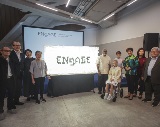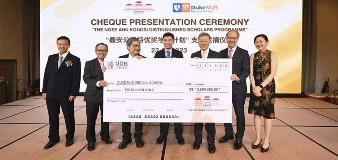The past century has been filled with many novel medical discoveries and even moonshots for the Obstetrics & Gynaecology (O&G) Department at the NUS Yong Loo Lin School of Medicine, which is celebrating its 100th anniversary this year. From producing Asia’s first in-vitro fertilised baby to cultivating an ever-expanding pool of award-winning scientists and clinicians, the department is now actively exploring future frontiers such as studying reproduction and fertility issues in the space-faring age.
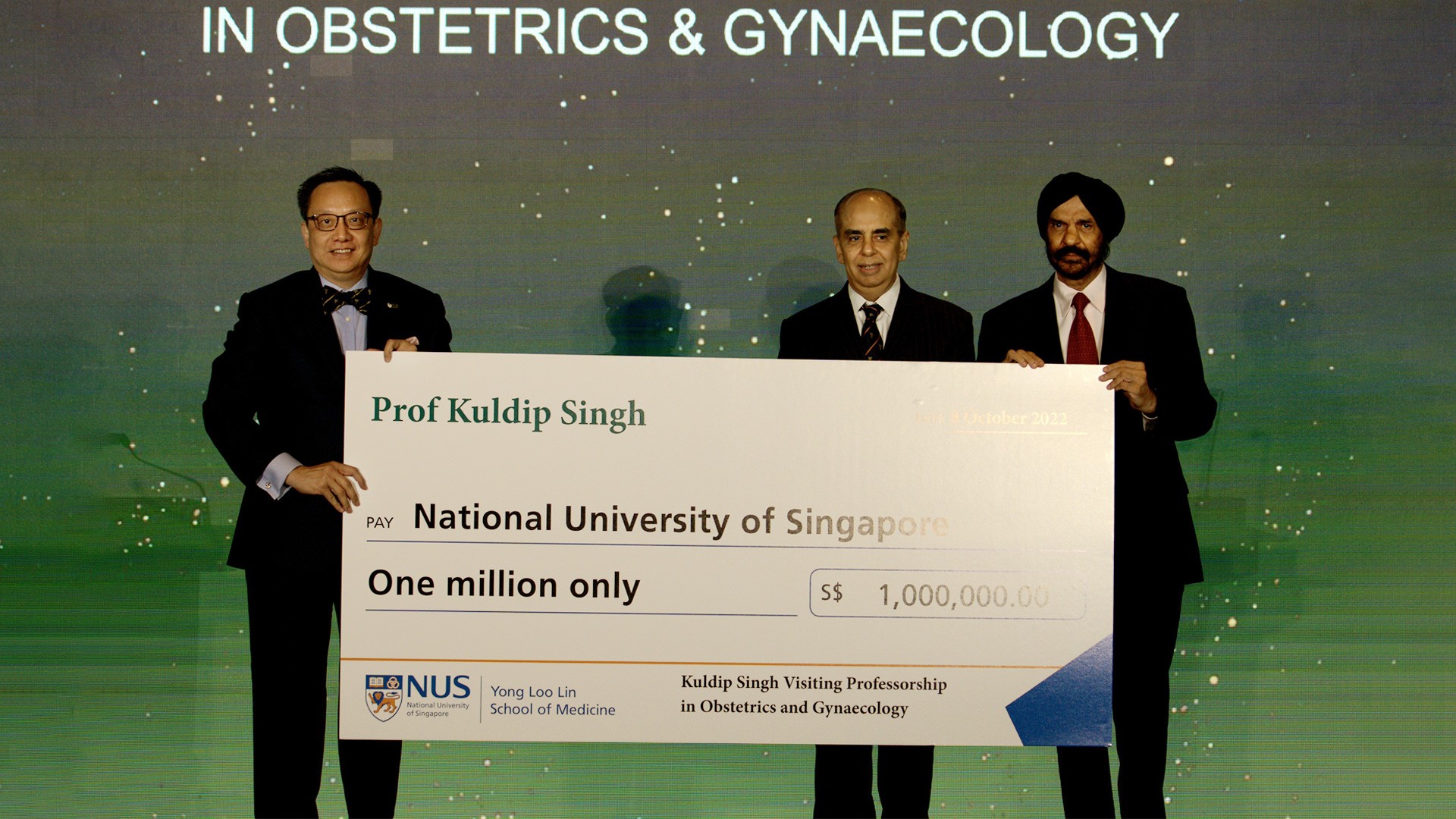 Professor Kuldip Singh (right), senior consultant in the Obstetrics & Gynaecology (O&G) Department, presenting the cheque of S$1 million to establish the Kuldip Singh Visiting Professorship in Obstetrics and Gynaecology to the Dean of NUS Medicine, Professor Chong Yap Seng (left) and O&G Head of Department Associate Professor Mahesh Choolani (middle).
Professor Kuldip Singh (right), senior consultant in the Obstetrics & Gynaecology (O&G) Department, presenting the cheque of S$1 million to establish the Kuldip Singh Visiting Professorship in Obstetrics and Gynaecology to the Dean of NUS Medicine, Professor Chong Yap Seng (left) and O&G Head of Department Associate Professor Mahesh Choolani (middle).
The past century has been filled with many novel medical discoveries and even moonshots for the Obstetrics & Gynaecology (O&G) Department at the NUS Yong Loo Lin School of Medicine, which is celebrating its 100th anniversary this year.
From producing Asia’s first in-vitro fertilised baby to cultivating an ever-expanding pool of award-winning scientists and clinicians, the department is now actively exploring future frontiers such as studying reproduction and fertility issues in the space-faring age.
Through its long and illustrious history, it has maintained an “unwavering commitment to maternal and child health”, noted Madam Halimah Yacob, President of the Republic of Singapore at the opening ceremony of the two-day Centenary Celebration Conference on October 8 and 9.
Some 573 O&G specialists and medical professionals attended the two-day hybrid conference held online and at Raffles City Convention Centre, where Madam Halimah officiated the launch of three new scholarships.
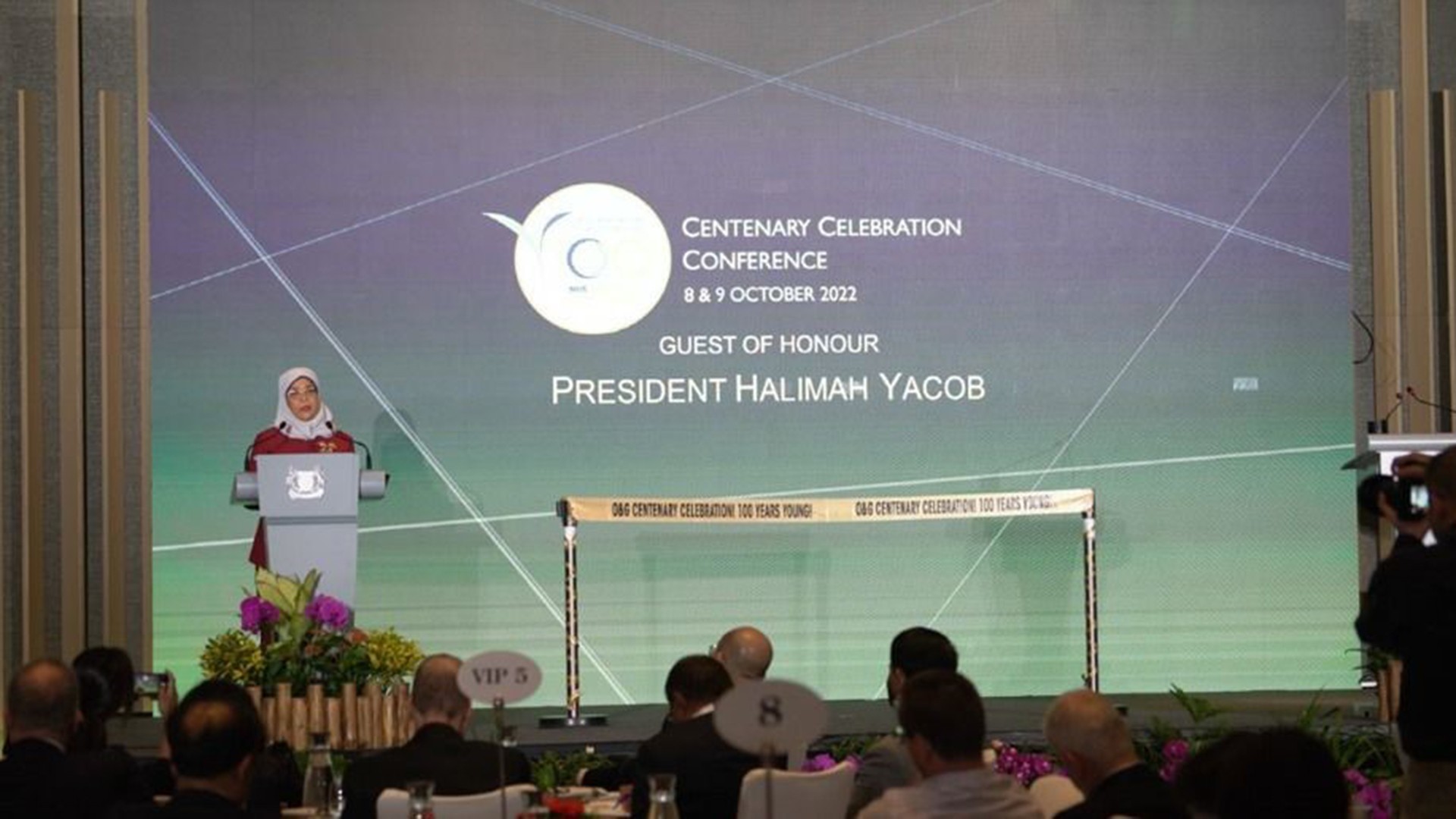
Madam Halimah Yacob, President of the Republic of Singapore, speaking at NUS Department of Obstetrics and Gynaecology Centenary Celebration Conference.
The first was the Kuldip Singh Visiting Professorship in Obstetrics and Gynaecology, which would enable highly-regarded professors in any O&G field to spend time at the department building research alliances and mentoring young academics.
The second was the Sabaratnam Arulkumaran Scholarship, which facilitates collaboration between Singapore and institutions in neighbouring countries by supporting young academic clinicians and scientists aiming to conduct clinical or scientific research at NUS O&G.
The third was the O&G Centennial Bursary, funded with donations from 26 consultants and senior consultants from the department, which provides financial support to less well-off undergraduate medical students.
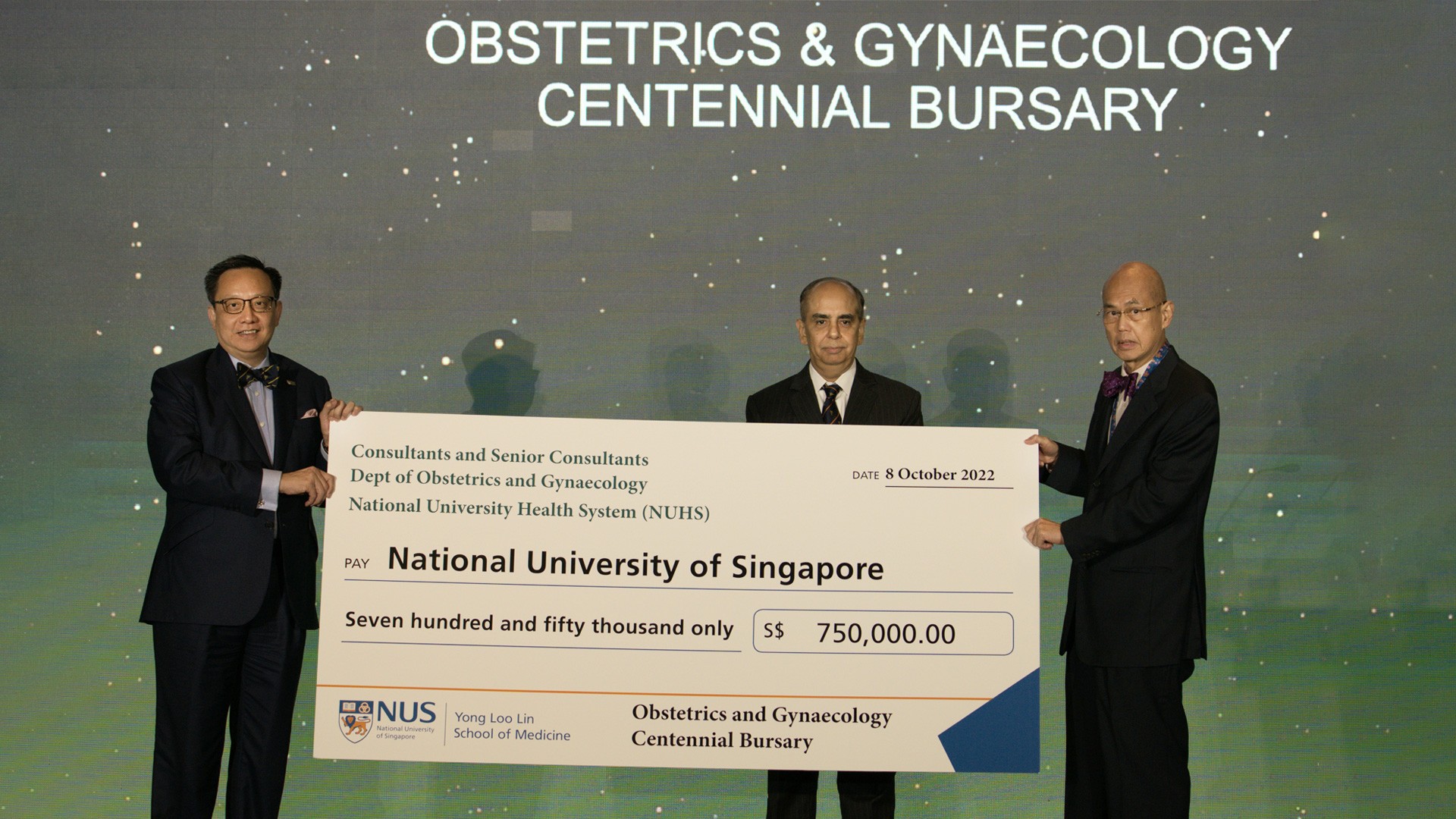
Professor Wong Peng Cheang, Head of the Division of Reproductive Endocrinology & Infertility at the O&G department (right), presenting the cheque of S$750,000 to establish the O&G Centennial Bursary to the Dean of NUS Medicine, Professor Chong Yap Seng (left) and O&G Head of Department Associate Professor Mahesh Choolani (middle).
Home to illustrious alumni
The department’s long-standing commitment to research builds on the contributions of its past trailblazing leaders such as Professor Benjamin Henry Sheares, who served as head of department from 1941 to 1958.
Professor Sheares, who later became Singapore’s second President, pioneered new gynaecological procedures for pelvic organ reconstruction that gained worldwide recognition.
Other illustrious leaders and alumni include Prof SS Ratnam, who was the longest-serving head of department and founder of Singapore’s in vitro fertilisation (IVF) programme.

Singapore's second President Benjamin Sheares (front row, second from right) took over as the O&G’s former Head of Department in 1941. He is seen here at the University Unit of Kandang Kerbau Hospital, where the Department was located prior to its move to the National University Hospital in 1985.
NUS O&G’s research achievements include pioneering research and discovery of embryo and reproductive stem cell biology at the start of life, as well as significant discoveries into the roles of prostaglandins (hormone-like compounds that play a key role in creating uterine contractions for labour) and human chorionic gonadotrophin (a hormone produced by the placenta) in pregnancy.
“Today, NUS O&G is known to be the home of globally recognised academic endeavours,” said NUS President Professor Tan Eng Chye in his address at the conference, whose theme was “Women-Health-Life”.
He highlighted some recent medical advances, such as more accurate and inclusive non-invasive prenatal screening to help mothers make timely decisions about their pregnancies, as well as new techniques to treat babies with certain illnesses even before birth.
“We are also seeing exciting developments in reproductive ageing, formulation of precision therapies for cancers and other illnesses afflicting women, and preserving health well into old age,” he added.
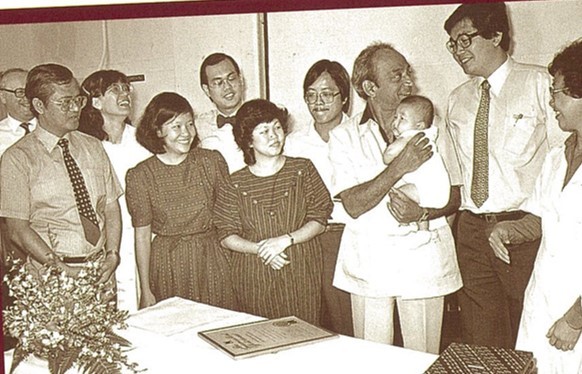
Asia's first successful in-vitro fertilisation baby, Samuel Lee, is carried by Professor SS Ratnam (third from right), the former Head of Department (HOD) from 1969 to 1995. Also in the photo are Professor Ng Soon Chye (HOD 1997 – 2001, second from right), Mrs Lee, the baby’s mother (sixth from right), and Professor Wong Peng Cheang (fifth from right, HOD 2001 – 2008).
Shooting for the stars and space
NUS O&G’s visionary approach has led to exploration in research that might be viewed – quite literally – as moonshots but could have far-reaching implications for humankind. For instance, it started microgravity experiments this year to understand the impact of lunar level gravity on cell proliferation.
“Very early preliminary data suggests moon-level gravity affects stem cell replication. We know that the foetus and the placenta are all about the stem cells,” said NUS O&G Head of Department Mahesh Choolani.
“If we are going to be a space-faring society, we need to study…fertility and pregnancy in a microgravity environment. And it can start right here in our department.”
By its 150th anniversary, NUS O&G hopes to be making contributions in research areas like reproduction and pregnancy under current pressures – such as population, global warming and other environmental stressors – as well as in the field of exo-planetary science, said Associate Professor Choolani. “By our 200th anniversary, we hope (to be) major players and contributors (in these fields)”.
The department, which currently holds approximately S$20 million in grant funding, has 26 research investigators as well as a pool of research assistants and collaborators working on a broad range of topics, added NUS O&G Research Director, Associate Professor Citra Mattar.
These include infertility, high risk pregnancies and congenital disorders, healthy growth and disease prevention, sexuality, cancer prevention and treatment, and disorders of ageing.
The department is also leveraging “FemTech” – high-tech medical solutions that improve healthcare outcomes for females – as well as applying technologies like artificial intelligence and machine learning to improve patient care and diagnostic accuracy, among others.
Championing women’s health
One key issue that requires greater attention is the widening longevity and health gap between men and women.
Women are living longer but not ageing more healthily, and their state of health continues to lag behind that of men’s, observed Professor Chong Yap Seng, Dean of NUS Medicine, in his opening address at the conference.
Another issue relates to declining fertility and reproductive health, as more women join the workforce, marry and have children later and experience changing lifestyles.
All these “cannot be resolved by women or healthcare professionals alone but require a whole-of-society and government effort”, added Prof Chong.
The department is also expanding its efforts to improve women’s access to quality healthcare across the region, honouring the legacy of its highly respected alumnus and long-time champion of women’s health, former head of NUS O&G, Professor Sir Sabaratnam Arulkumaran.
His many titles include Professor Emeritus of Obstetrics and Gynaecology at the St George’s University of London, and Past President of the British Medical Association.
In his keynote address at the conference, Prof Arul – as he is fondly known at NUS – urged the department to be “ambassadors of women’s sexual and reproductive rights”, particularly in less-developed regions, over the next 100 years.
To serve women and communities better, the department has undergone a major paradigm shift – from healthcare to caring for health. “The doctors, general practitioners and OBGYNs of the future must shift their focus from lifespan to healthspan, episodic care to a life-cost approach, from restoring health and curing disease to preventing disease and maintaining health,” said Assoc Prof Choolani.
This story was first published on 28 October 2022 on NUS News. Click here for more NUS News stories.



